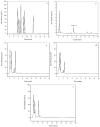A Novel Streptococcus thermophilus FUA329 Isolated from Human Breast Milk Capable of Producing Urolithin A from Ellagic Acid
- PMID: 37431038
- PMCID: PMC9601659
- DOI: 10.3390/foods11203280
A Novel Streptococcus thermophilus FUA329 Isolated from Human Breast Milk Capable of Producing Urolithin A from Ellagic Acid
Abstract
Urolithin A, a metabolite of ellagic acid, has many beneficial biological activities for people. Strains capable of producing urolithin A from ellagic acid have the hope of becoming the next-generation probiotics. However, only a few species of these strains have been reported. In this study, FUA329, a strain capable of converting ellagic acid to urolithin A in vitro, was isolated from the breast milk of healthy Chinese women. The results of morphological observation, physiological and biochemical tests, and 16S rRNA gene sequence analysis confirmed that the strain FUA329 was Streptococcus thermophilus. In addition, the S. thermophilus FUA329 growth phase is consistent with the degradation of ellagic acid, and urolithin A was produced in the stationary phase, with a maximum concentration of 7.38 μM at 50 h. The corresponding conversion efficiency of urolithin A from ellagic acid was 82%. In summary, S. thermophilus FUA329, a novel urolithin A-producing bacterium, would be useful for the industrial production of urolithin A and may be developed as a next-generation probiotic.
Keywords: Streptococcus thermophilus; biotransformation; ellagic acid; human breast milk; urolithin A.
Conflict of interest statement
The authors declare no conflict of interest.
Figures




Similar articles
-
Genomic and phenotypic-based safety assessment and probiotic properties of Streptococcus thermophilus FUA329, a urolithin A-producing bacterium of human milk origin.Genomics. 2023 Nov;115(6):110724. doi: 10.1016/j.ygeno.2023.110724. Epub 2023 Oct 10. Genomics. 2023. PMID: 37820823
-
Improvement of Urolithin A Yield by In Vitro Cofermentation of Streptococcus thermophilus FUA329 with Human Gut Microbiota from Different Urolithin Metabotypes.J Agric Food Chem. 2024 Feb 14;72(6):3008-3016. doi: 10.1021/acs.jafc.3c09734. Epub 2024 Feb 1. J Agric Food Chem. 2024. PMID: 38301119
-
Isolation and characterization of a novel human intestinal Enterococcus faecium FUA027 capable of producing urolithin A from ellagic acid.Front Nutr. 2022 Nov 9;9:1039697. doi: 10.3389/fnut.2022.1039697. eCollection 2022. Front Nutr. 2022. PMID: 36438752 Free PMC article.
-
Ellagic acid and intestinal microflora metabolite urolithin A: A review on its sources, metabolic distribution, health benefits, and biotransformation.Crit Rev Food Sci Nutr. 2023;63(24):6900-6922. doi: 10.1080/10408398.2022.2036693. Epub 2022 Feb 10. Crit Rev Food Sci Nutr. 2023. PMID: 35142569 Review.
-
Biochemistry, genetics, and applications of exopolysaccharide production in Streptococcus thermophilus: a review.J Dairy Sci. 2003 Feb;86(2):407-23. doi: 10.3168/jds.S0022-0302(03)73619-4. J Dairy Sci. 2003. PMID: 12647947 Review.
Cited by
-
Ellagic Acid and Gut Microbiota: Interactions, and Implications for Health.Food Sci Nutr. 2025 Apr 6;13(4):e70133. doi: 10.1002/fsn3.70133. eCollection 2025 Apr. Food Sci Nutr. 2025. PMID: 40196228 Free PMC article. Review.
-
Differential Role of Active Compounds in Mitophagy and Related Neurodegenerative Diseases.Toxins (Basel). 2023 Mar 6;15(3):202. doi: 10.3390/toxins15030202. Toxins (Basel). 2023. PMID: 36977093 Free PMC article. Review.
-
In vitro conversion of ellagic acid to urolithin A by different gut microbiota of urolithin metabotype A.Appl Microbiol Biotechnol. 2024 Feb 16;108(1):215. doi: 10.1007/s00253-024-13061-1. Appl Microbiol Biotechnol. 2024. PMID: 38363367 Free PMC article.
-
The microbial metabolite urolithin A reduces Clostridioides difficile toxin expression and toxin-induced epithelial damage.mSystems. 2024 Feb 20;9(2):e0125523. doi: 10.1128/msystems.01255-23. Epub 2024 Jan 9. mSystems. 2024. PMID: 38193707 Free PMC article.
-
Body Composition and Senescence: Impact of Polyphenols on Aging-Associated Events.Nutrients. 2024 Oct 25;16(21):3621. doi: 10.3390/nu16213621. Nutrients. 2024. PMID: 39519454 Free PMC article. Review.
References
-
- Seeram N.P., Aronson W.J., Zhang Y., Henning S.M., Moro A., Lee R.P., Sartippour M., Harris D.M., Rettig M., Suchard M.A., et al. Pomegranate ellagitannin-derived metabolites inhibit prostate cancer growth and localize to the mouse prostate gland. J. Agric. Food Chem. 2007;55:7732–7737. doi: 10.1021/jf071303g. - DOI - PubMed
Grants and funding
LinkOut - more resources
Full Text Sources

